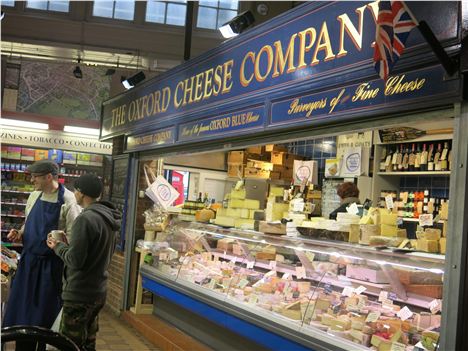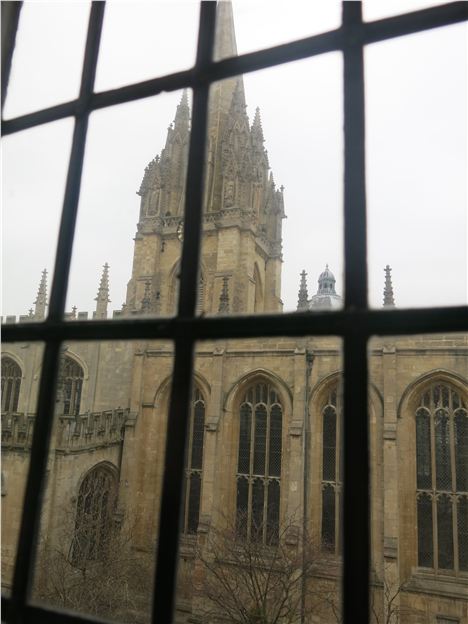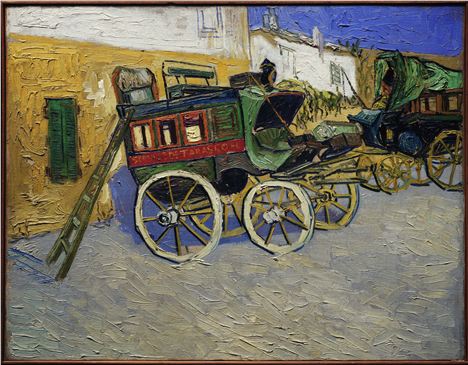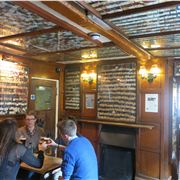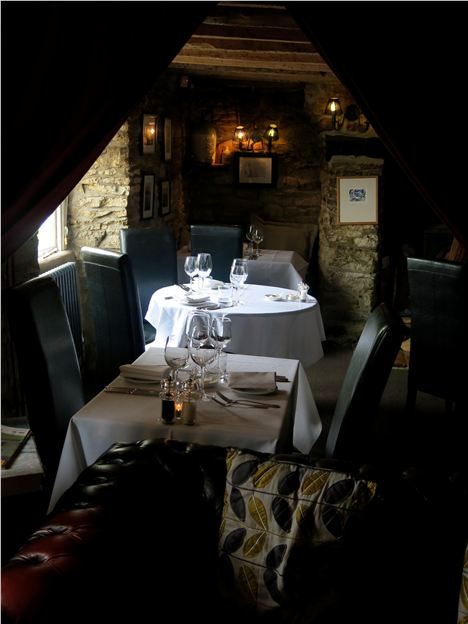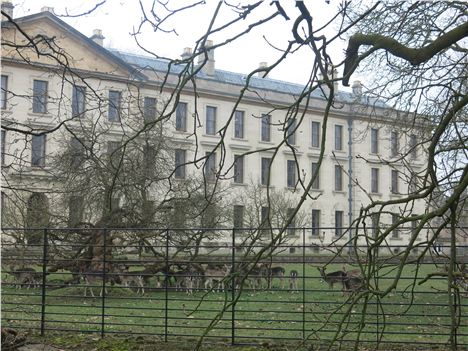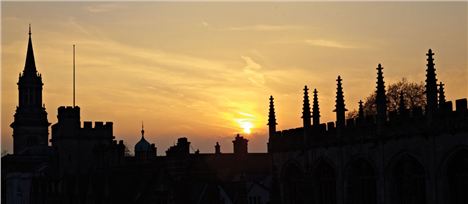I REMEMBER as a student banking at Barclays on Oxford High Street, looting my student grant for beer money. You had to fill in a form at a counter. Cash dispensers – cellphones, CDs, the Premier League, too – were yet to be invented.
'Morris dancers cavort and young revellers fresh (or maybe not so fresh) from all-night balls attempt to evade security guards and Daily Mail reporters and leap from the Bridge'
Now in 2014 I am sitting in an all-day brasserie in that same building, sipping an American style IPA and surveying Oxford’s new hybrid eco-buses sweeping past up towards Cornmarket.
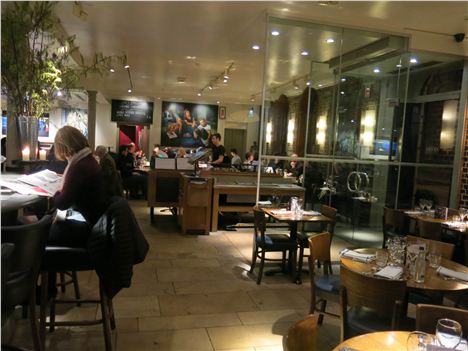 The buzzing Quod brasserie at the Old Bank
The buzzing Quod brasserie at the Old Bank
There are still butchers and a coffee merchants I remember in the Covered Market from the old days but they are way outnumbered by shoe sellers and cupcakeries.
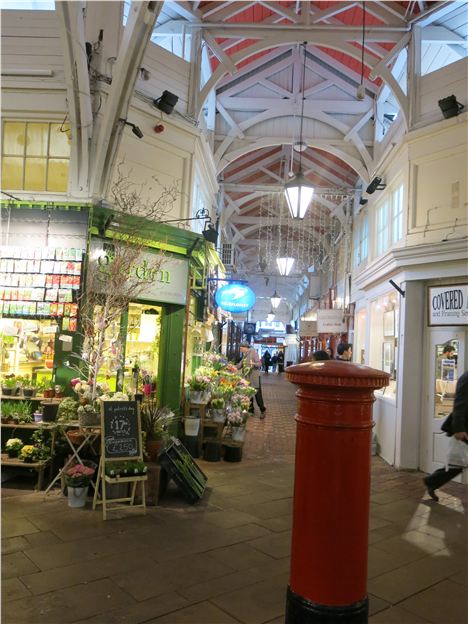 Oxford's Covered Market; buy picnic ingredients from the artisan cheese stall
Oxford's Covered Market; buy picnic ingredients from the artisan cheese stall
Times change. The Old Bank Hotel has been occupying these much-changed, centuries-old (fleeetingly Barclays) buildings since 1998. I love its central position, opposite St Mary’s Church – one of those Dreaming Spires of legend – making it the perfect base to explore this endlessly fascinating city. It even has its own parking discreetly housed off Magpie Lane, leading down to medieval Merton College and Christ Church Meadows.
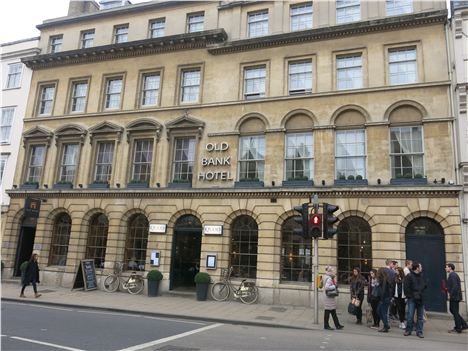 The Old Bank, in the middle of the HIgh, couldn't be handier
The Old Bank, in the middle of the HIgh, couldn't be handier
 Our gorgeous Deluxe Suite and, below, its view of St Mary's
Our gorgeous Deluxe Suite and, below, its view of St Mary's
 Geraldine Knight's Deborah, part of Jeremy Mogford's art collection, below
Geraldine Knight's Deborah, part of Jeremy Mogford's art collection, below
The 42-room boutique property is lovely in its own right, filled with artworks collected by owner Jeremy Mogford. But it’s spring and Oxford is calling. Here are 10 randomly summoned reasons to visit:
1 The heart of Oxford is a work of art in its own right. That’s only been enhanced by the imaginative redevelopment – admittedly at a cost of £61m – of its greatest repository of art and antiquities, The Ashmolean. Now comes its first big league exhibition, Cezanne and The Modern (March 13 to June 22 2014). It’s quite a coup and sure to be oversubscribed, but make the effort to get there. Gaze close up at the the masterpiece at the heart of this show, one of Cézanne's oil paintings of Mont Sainte-Victoire, the Provençal peak he could see from his studio window.
 Mont Sainte-Victoire and, below, Van Gogh's Tarascon Stage Coach
Mont Sainte-Victoire and, below, Van Gogh's Tarascon Stage Coach
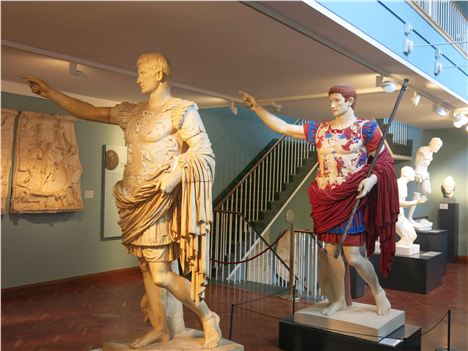 Some pointers from the Ashmolean's classical collection
Some pointers from the Ashmolean's classical collection
If modern art begins anywhere it begins here in these pixelated planes of vision. Cezanne’s range of oil and water colours is fully represented and there’s the bonus of other artists’ work from the Pearlman family collection, notably Van Gogh’s hallucinatory 1888 painting Tarascon Stagecoach. Go another day and take in how wonderfully the new Ashmolean exhibits its many treasures, then chill out in the top floor cafe with its stunning rooftop terrace.
2 Great though all this art is, in the city where the written word is king, it’s not going to trump the Oxford Literary Festival, now sponsored by FT Weekend. It runs from Saturday, March 22, to Sunday, March 30 in ideal venues such as the Bodleian Library, the Sheldonian Theatre and Christ Church College.
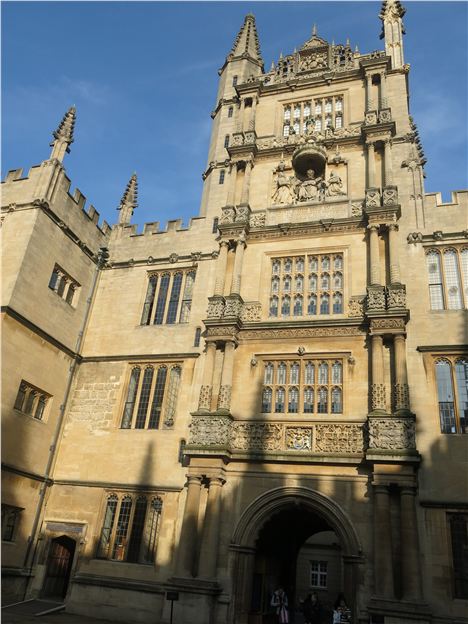 Bodleian, major venue for the Oxford Literary Festival
Bodleian, major venue for the Oxford Literary Festival
 Margaret AtwoodNovelists dominate this year’s line-up. They include the Nobel Prize winner from Turkey, Orhan Pamuk (delivering the Chancellor’s Lecture), and five Booker Prize winners: Eleanor Catton (2013); John Banville (2005); Margaret Atwood (2000), who will speak at the HSBC festival closing dinner; Ian McEwan (1998), who will deliver the Bodley Lecture; and Ben Okri (1991), who will give the inaugural Gibraltar Lecture. In total there are 500 speakers from more than 20 countries. For full details and to book visit http://oxfordliteraryfestival.org.
Margaret AtwoodNovelists dominate this year’s line-up. They include the Nobel Prize winner from Turkey, Orhan Pamuk (delivering the Chancellor’s Lecture), and five Booker Prize winners: Eleanor Catton (2013); John Banville (2005); Margaret Atwood (2000), who will speak at the HSBC festival closing dinner; Ian McEwan (1998), who will deliver the Bodley Lecture; and Ben Okri (1991), who will give the inaugural Gibraltar Lecture. In total there are 500 speakers from more than 20 countries. For full details and to book visit http://oxfordliteraryfestival.org.
3 Oxford offers a wealth of atmospheric (and acoustically brilliant) places to listen to classical and medieval music. Most of the colleges host concerts, but I’d particularly recommend the Holywell Music Room. It first opened its doors in 1748, making it the oldest oldest custom-built concert hall in Europe. A more recent, more modest venue is St John the Evangelist Church, at 109A Iffley Road.
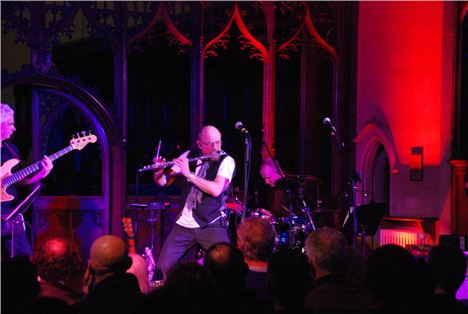 Jethro Tull rock them in the aisles
Jethro Tull rock them in the aisles
Eclectic offerings in coming months range from Bach’s St Matthew Passion to the experimental jazz band Polar Bear. Before Christmas Jethro Tull played a fund-raiser to help repairs for this Grade 1 listed venue, built in the 1890s for a Christian brotherhood known as the “Cowley Fathers”.
4 The next musical step is Choral Evensong. This 45 minute church service was written by Thomas Cranmer, the Archbishop of Canterbury who, during Mary Tudor's reign, was tried for heresy in Oxford’s University Church and burned to death in Broad Street.
 Magdalen College Choir in the Chapel
Magdalen College Choir in the Chapel
Most evenings during term-time you can catch a service at some college or other. Three of them even have their own choir schools, which produce boy trebles – Magdalen, Christ Church, New College. It’s a beautiful experience – and free. Ask at the porter’s lodge.
5 The O2 Academy and New Theatre are the prime touring rock venues in Oxford and there are lots of enthusiastic smaller gig places, but Manchester it ain’t. There’s no sign of Radiohead tours yet – or a Supergrass Trail, but it is mildly diverting to trace the bands’ roots. So head for Jericho, a modest former workers’ quarter now gentrified with lots of individual shops and eateries especially along Walton Street (check out the Jericho Street Fair in mid-June).
 Jericho Tavern – an attractive local with a heady rock past
Jericho Tavern – an attractive local with a heady rock past
 In 1986 at the Jericho Tavern (still there today as an attractive local, hosting bands) Radiohead played their first gig under the name On A Friday. The “Club Avocado” poster proclaimed “Oxford needs live music”. Today you’ll find a heritage plaque in the pub unveiled by fellow Oxonians, Supergrass in 2012. Now disbanded, they appeared there regularly (as Theodore Supergrass initially) until they got a record deal in 1994.
In 1986 at the Jericho Tavern (still there today as an attractive local, hosting bands) Radiohead played their first gig under the name On A Friday. The “Club Avocado” poster proclaimed “Oxford needs live music”. Today you’ll find a heritage plaque in the pub unveiled by fellow Oxonians, Supergrass in 2012. Now disbanded, they appeared there regularly (as Theodore Supergrass initially) until they got a record deal in 1994.
6 Where to eat? Oxford, in truth, is not a haven of gastronomy. The richer colleges boast fabulous wine cellars and high tables can rise to the occasion for formal dinners, but college food is mostly an extension of school dinners, while the town’s restaurants are distinctly middling (different in the Seventies briefly when a young Raymond Blanc was cooking up a storm in Summertown).
 Magdalen Arms – leading a gastro revolution along the Iffley Road
Magdalen Arms – leading a gastro revolution along the Iffley Road
 Aubergine curry at Oli's ThaiBest bet is to wander for 15 minutes down the Iffley Road to what has the makings of a foodie enclave. A relaxed gastropub, the Magdalen Arms, No 243 but on the corner with Magdalen Street, came first, pleasing metropolitan food critics (and me). There soon followed in close proximity the organic cafe Oxfork, community pub The Rusty Bicycle, Oxford Blue and the revamped Chester Arms. Now Oli’s Thai, at 38 Magdalen Road and named after the owners’ four-year-old son, is wowing with its authentic Thai cooking, a world away from the microwaved pub green curry.
Aubergine curry at Oli's ThaiBest bet is to wander for 15 minutes down the Iffley Road to what has the makings of a foodie enclave. A relaxed gastropub, the Magdalen Arms, No 243 but on the corner with Magdalen Street, came first, pleasing metropolitan food critics (and me). There soon followed in close proximity the organic cafe Oxfork, community pub The Rusty Bicycle, Oxford Blue and the revamped Chester Arms. Now Oli’s Thai, at 38 Magdalen Road and named after the owners’ four-year-old son, is wowing with its authentic Thai cooking, a world away from the microwaved pub green curry.
7 Oh, yes, Pubs. The food-centric Magdalen Arms is not a place I’d choose to go for a beer. Neither are lots of trad city centre pubs for different reasons. Too many literary ghosts (Tolkien, CS Lewis and mates at the Lamb and Flag); too many tourists (too many pubs to name). I’ll just suggest two.
 The Bear lives up to its ancient pedigree; below, its famous tie collection
The Bear lives up to its ancient pedigree; below, its famous tie collection
The Bear Inn (6 Alfred Street, OX1 4EH, is tucked in behind Christ Church, a minute from the High Street. Oxford’s oldest pub, dating back to 1242, a braying crowd can dominate its tiny interior – famous for a wall-to-wall tie collection – but catch it at a quiet time and it’s a wonderful place to sit and read with a pint of Fuller’s London Pride. You have to make an effort to get to the equally intimate Rose and Crown. It’s a mile and a half up the Banbury Road (14 North Parade Avenue OX2 6LH). Three small rooms, no music, regular Adnams beers plus guest beers along with a proper mixed crowd
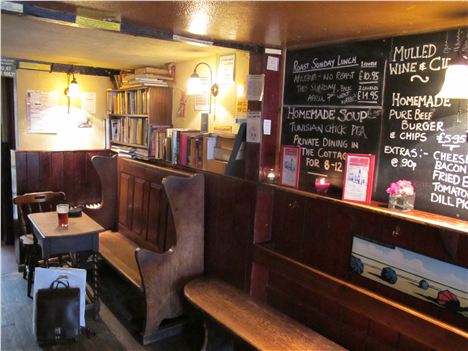 The cosy Rose and Crown is worth the trek out
The cosy Rose and Crown is worth the trek out
8 When you’ve had enough of being forced off pavements by parties of Spanish schoolchildren or keen amateur photographers from Yokohama, get out for a few hours. Blenheim and the Cotswold villages maybe, but you’ll still get the crowds. Stray off the beaten Oxfordshire track, instead, to Murcott and Ewelme. Where, you might ask? There are reasons. The first village, up on windswept Otmoor 15 miles to the north east (off the A34) is home to one of the few pubs to make it into the CAMRA Good Beer Guide and hold a Michelin star.
 The Nut Tree looks the part and delivers fine ale and food
The Nut Tree looks the part and delivers fine ale and food
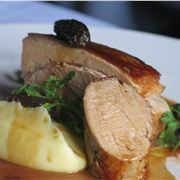 The Nut Tree Inn is also incredibly idyllic with its thatched eaves and duck pond. Behind, rare breed pigs roam. So do order the belly pork (pictured right). But almost everything on Mike North’s menu is sustainable, well sourced and intense in flavour. Immaculately kept Butcombe Bitter was a fine accompaniment.
The Nut Tree Inn is also incredibly idyllic with its thatched eaves and duck pond. Behind, rare breed pigs roam. So do order the belly pork (pictured right). But almost everything on Mike North’s menu is sustainable, well sourced and intense in flavour. Immaculately kept Butcombe Bitter was a fine accompaniment.
Ewelme, to the south of Oxford towards Watlington, used to be famous for its watercress beds, but these are no longer commercially viable. Still they make an attractive nature reserve. But they are not the reason to visit this out-of-the-way Chilterns village. The lure is a 15th century combo of church, rectory, school and almshouses. It all once was the fief of William Chaucer’s son, Thomas. His daughter Alice married William de Pole, a man on the up, future Duke of Suffolk.
 The cadaver of Alice de la Pole; below, Ewelme's almshouses
The cadaver of Alice de la Pole; below, Ewelme's almshouses
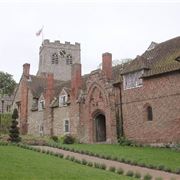 _As Simon Jenkins says in his magisterial England’s Thousand Best Churches “Because of the connection with the Dukes of Suffolk, the architecture, the tomb and the famous "angel" roof in the chapel of St. John the Baptist have more in common with East Anglian churches than nearer neighbours in Oxfordshire.” Alice’s tomb inside St Mary's church is the centre of attraction – not just for the formal alabaster monument but also for the carved cadaver representing the lady in death.
_As Simon Jenkins says in his magisterial England’s Thousand Best Churches “Because of the connection with the Dukes of Suffolk, the architecture, the tomb and the famous "angel" roof in the chapel of St. John the Baptist have more in common with East Anglian churches than nearer neighbours in Oxfordshire.” Alice’s tomb inside St Mary's church is the centre of attraction – not just for the formal alabaster monument but also for the carved cadaver representing the lady in death.
9 Of course, you could just stay in the town and visit a college, though expect to pay an average of £2, visits usually restricted to afternoons. Snooty Christ Church is asking £7.50, though you do get the Chapter House and Cathedral as extras. If I had to recommend one it would have to be Magdalen, though I’m not entirely unbiased having spent three gloriously happy years as an undergraduate there.
 Magdalen's Tower, Cloisters and New Building, seen from the New Building
Magdalen's Tower, Cloisters and New Building, seen from the New Building
 It has a soaring Tower, atmospheric Cloisters, the magnificent 18th century New Building, punting opportunities by Magdalen Bridge, a deer park and, the best 20 minute stroll in Oxford, circling the Water Meadow on Addison’s Walk. Here in the meadow each spring since 1785 has grown the rare green-purple Fritillaria Meleagris (commonly known as Snakeshead Fritillary). Magdalen is less tranquil on May Morning. The Magdalen College Choir sing like angels from the top of the Tower at 6am, Morris dancers cavort and young revellers fresh (or maybe not so fresh) from all-night balls attempt to evade security guards and Daily Mail reporters and leap from the Bridge. If the water levels are low the Radcliffe Infirmary may get busy.
It has a soaring Tower, atmospheric Cloisters, the magnificent 18th century New Building, punting opportunities by Magdalen Bridge, a deer park and, the best 20 minute stroll in Oxford, circling the Water Meadow on Addison’s Walk. Here in the meadow each spring since 1785 has grown the rare green-purple Fritillaria Meleagris (commonly known as Snakeshead Fritillary). Magdalen is less tranquil on May Morning. The Magdalen College Choir sing like angels from the top of the Tower at 6am, Morris dancers cavort and young revellers fresh (or maybe not so fresh) from all-night balls attempt to evade security guards and Daily Mail reporters and leap from the Bridge. If the water levels are low the Radcliffe Infirmary may get busy.
 10 What you can’t see just yet, but watch this space...
10 What you can’t see just yet, but watch this space...
One of Oxford’s great secret places is to be found upstairs above a bookie’s on the commercial main drag of Cornmarket. Behind an 18th-century façade lies The Painted Room – the remains of the 14th century Crown Tavern with remarkable Elizabethan wall paintings. The still existing Crown Inn across the road was merely the stables and drinking den, but the Tavern provided a bed, en route to Stratford, for one William Shakespeare, who has been linked romantically with the landlord’s wife, Jane Davenant.
 The Painted Room is Oxford's hidden gem
The Painted Room is Oxford's hidden gem
Two of the Painted Room’s walls are entirely covered with hand-painted decorative floral and trellis designs. A religious inscription runs along the top of the design and reads: ‘And last of thi rest be thou / Gods servante for that hold I best / In the mornynge earlye / Serve god devoutlye / Feare god above allthynge (…)’. Above the fireplace is a slightly older (probably c.1550s) “IHS” – “Jesus” in Greek. The Room is not open to the general public yet. Become a member of the Oxford Preservation Trust and there’s a chance of an occasional visit. Negotiations are underway to try and improve access. Meanwhile, the OPT are celebrating the Bard’s 450th anniversary with a civic event planned for April 23, 2014.
Fact file
Neil stayed, in a Superior Deluxe Double at the Old Bank Hotel, 92-94 High St, Oxford OX1 4BJ. Room rates fluctuate according to season and room type. So a night’s stay could anything between cost between £150 and £500, to include room, VAT and internet access.
The Old Bank and its Quod Bar are owned by the tireless Jeremy Mogford. Creator 40 years ago of the Browns restaurant chain (later sold), he owns Gee’s restaurant up the Banbury Road as well as the delightful Old Parsonage Hotel, due to re-open after dramatic refurbishment at the end of March 2014. Like the Old Bank, it is a showcase for his extensive 20th century and contemporary art collection. He is also sponsor of the £7,500 Jeremy Mogford Prize for Food and Drink Writing, a short story with a food theme competition launched in 2013. This 2014 winner will be announced at the Literary Festival.








